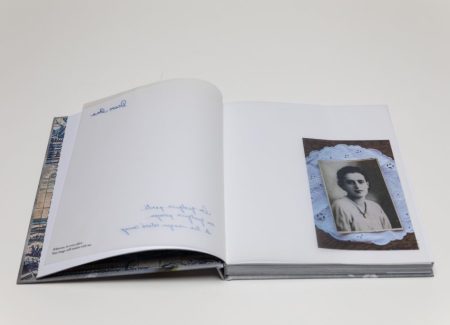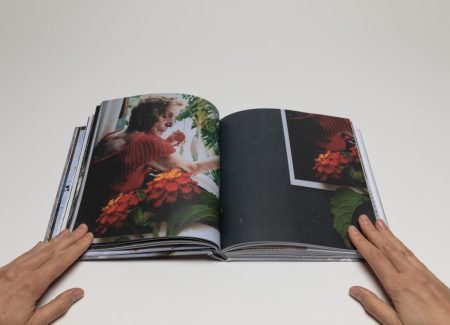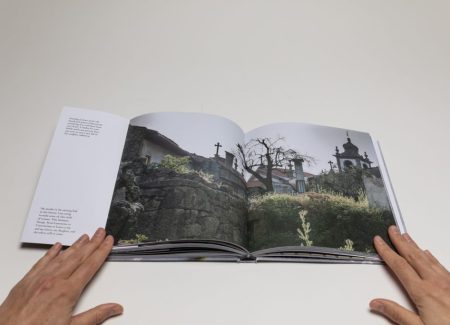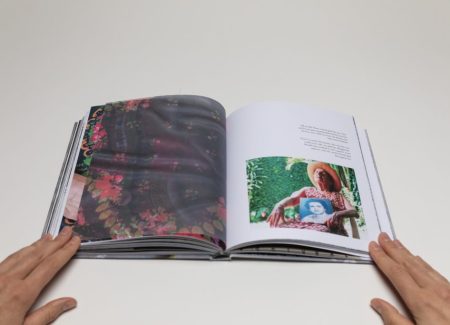JTF (just the facts): Published in 2021 by Hurtwood Press (here). Hardcover (23.5 x 21 cm), 204 pages, with 85 photographs and archival images. Includes essays by the artist, Octavia Bright, and Ângela Ferreira. Design by Billie Temple. (Cover and spread shots below.)
Comments/Context: Dear Ana is a photobook by the Brazilian photographer Leticia Valverdes, and offers an intimate and moving journey back to the motherland of the artist’s grandmother. The project started during Valverdes’s residency in Portugal, the place where her grandmother was born but left in 1921 at the age of one and a half, when the family emigrated to Brazil. One of Ana’s big dreams was to visit Portugal again, and in her final years, confused by progressing Alzheimer’s, Ana started to believe she still had friends in her place of birth. Eleven years after her grandmother’s death, Valverdes visited the tiny village of Mundão in northern Portugal where her grandmother was born.
Ana wanted to become a pianist, but her father would only allow her to be a seamstress, and occasionally she was allowed to be a hair model without revealing her face. Valverdes was born and grew up in São Paulo, and was very close with her grandmother. During their visits to local farm markets, the grandmother would often touch various fabrics and explain to Valverdes the differences between their textures. “My grandmother wanted a better life for me. She wanted me to have choices she never had, she wanted me to marry a man I loved, and most of all she wanted me to follow my dreams.” The book was published exactly 100 years after Ana left Portugal, and Valverdes was awarded the prestigious Via Arts Prize for this series.
The design of the book employs elements that Valverdes associated with her grandmother: old family photographs, various fabrics, laces, and handwritten notes. Dear Ana feels like an intimate family album. The endpapers show ships sailing, a visual metaphor for Ana’s journey. The visual narrative of the book is also interspersed with poetry and intimate letters, immersing the viewer into this captivating story.
The book opens with a selection of old family photographs, showing Ana and her parents. The use of transparency paper between the pages reinforces the feeling of uncovering the layers in this story. A fictional letter from Ana to the artist, printed on a lighter paper, shares her life story in a poetic and moving narrative. And a couple of pages into the book, a photograph of a lipstick is placed next to a short poem. “I paint my lips red to / honour you. In the mirror, / my mouth is your mouth.” Valverdes then takes us to Portugal, to fulfill her grandmother’s dream.
While in Mundão, Valverdes showed local villagers Ana’s birth certificate and shared her story with them. She also asked them each to sign a postcard for Ana. The images of Mundão and the portraits of its residents are intertwined with archival pieces and Valverdes’s own reflections and poems. There are photographs of street corners, close ups of storefronts with fabrics on display, shadows on a cobblestone road, laundry drying outside, orange trees etc. A spread with a photograph of an abandoned house taken over by nature unfolds to the artist’s writing, as she imagines how this could have been the home of her grandmother.
The final section of the book pairs photographs of the locals with images of the postcards they wrote. A photograph of an old man named Antonio shot in his kitchen appears next to a postcard reading: “Ana I am the oldest man in Mundão… Like you, I also lived in Brazil. I really liked being there but I came (back) due to poor health.” When she talked to the local priest, based on various birth records, he was able to track down some of the artist’s family members who were still alive. The very last image in the book shows Ana’s own birth certificate, and the postcards connect Ana to a life she might have led.
In the past years, a number of photobooks have investigated family histories and archives. You can call me Nana by Will Harris (reviewed here) offers an intimate yet indirect portrait of the artist’s grandmother and her encroaching dementia. In A Parallel Road (reviewed here), Amani Willett uses his family story as a starting point for exploring the broader history of American racial violence. And Naïma El Kadi travels back to Morocco to probe her own split personal history in My Olive Tree, Memouna (reviewed here).
Dear Ana is a tender multi-layered narrative, and a thoughtful and personal photographic project. It fulfills a grandmother’s dream, while healing trans-generational traumas and reconnecting the artist with her family’s lost roots. Valverdes’s journey to reconnect with her grandmother’s past turned into a personal story with a universal dimension, one that is particularly relevant today given our ongoing debates about the many meanings of borders and national identity.
Collector’s POV: Leticia Valverdes does not appear to have gallery representation at this time. Collectors interested in following up should likely connect directly with the artist via her website (linked in the sidebar).






















